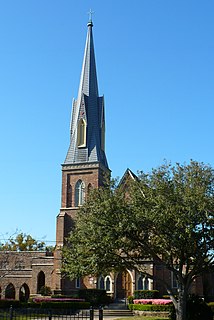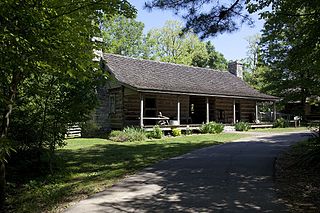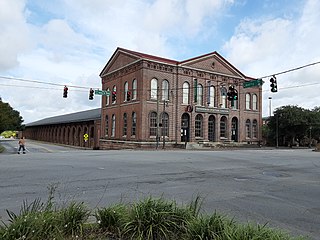
Huntsville is a city in Madison County, Limestone County, and Morgan County, Alabama, United States. It is the county seat of Madison County. Located in the Appalachian region of northern Alabama, Huntsville is the most populous city in the state.

The University of Alabama in Huntsville (UAH) is a public research university in Huntsville, Alabama. The university is accredited by the Southern Association of Colleges and Schools and comprises nine colleges: arts, humanities & social sciences; business; education; engineering; honors; nursing; professional & continuing studies; science; and graduate. The university's enrollment is approximately 10,000. It is part of the University of Alabama System and is classified among "R1: Doctoral Universities: Very High Research Activity".

The Huntsville-Madison County Public Library is a public, Carnegie library in Huntsville, Alabama. Founded in 1818, when Alabama was still a part of the Mississippi Territory, it is the oldest continuing library in the state.

The Georgia Trust for Historic Preservation is the United States' largest statewide, nonprofit preservation organization with more than 8,000 members. Founded in 1973 by Mary Gregory Jewett and others, the Trust is committed to preserving and enhancing Georgia's communities and their diverse historic resources for the education and enjoyment of all.
Twickenham Historic District was the first historic district designated in Huntsville, Alabama, USA. It was added to the National Register of Historic Places on January 4, 1973, with a boundary increase on May 26, 2015. The name derives from an early name for the town of Huntsville, named after Twickenham, England, by LeRoy Pope. It features homes in the Federal and Greek Revival architectural styles introduced to the city by Virginia-born architect George Steele about 1818, and contains the most dense concentration of antebellum homes in Alabama. The 1819 Weeden House Museum, home of female artist and poet Maria Howard Weeden, is open to the public, as are several others in the district.

The Old Town Historic District was the second historic district in Huntsville, Alabama. It was added to the National Register of Historic Places on July 18, 1978. Roughly bounded by Dement and Lincoln Sts., and Randolph and Walker Avenues, it features homes in a variety of styles including Victorian, Federal, Greek Revival, Queen Anne, American Craftsman, and even Prairie School with homes dating from the late 1820s through the early 20th century.

Episcopal Church of the Nativity is a church in Huntsville, Alabama. It was built in the Gothic Revival style in 1859. It is noted as one of the most pristine examples of Ecclesiological Gothic architecture in the South. It is also one of the least-altered structures by architect Frank Wills and one of only thirteen surviving houses of worship designed by him in the United States. It was declared a National Historic Landmark in 1990.

Frank Wills (1822–1857) was a British-born architect who is associated with the design of early Gothic Revival churches in North America.
Henry C. Dudley (1813–1894), known also as Henry Dudley, was an English-born North American architect, known for his Gothic Revival churches. He was a founding member of the American Institute of Architects and designed a large number of churches, among them Saint Paul's Episcopal Cathedral in Syracuse, New York, built in 1884, and Trinity Church, completed in 1858.
Clay Lancaster, was an authority on American architecture, an orientalist, and an influential advocate of historical preservation. According to The New York Times, Lancaster's 1961 study of the architecture of Brooklyn Heights "proved to be one of the earliest and loudest shots in the historic preservation struggle in New York City.”

Trinity Episcopal Church is a historic church in Mobile, Alabama, United States. It was the first large Gothic Revival church built in Alabama. The building was designed by architects Frank Wills and Henry Dudley.

Rosemount is a historic plantation house near Forkland, Alabama. The Greek Revival style house was built in stages between 1832 and the 1850s by the Glover family. The house has been called the "Grand Mansion of Alabama." The property was added to the National Register of Historic Places on May 27, 1971. The Glover family enslaved over 300 people from 1830 until 1860.

William Gibbons Preston was an American architect who practiced during the last third of the nineteenth century and in the first decade of the twentieth. Educated at Harvard University and the École des Beaux-Arts in Paris., he was active in Boston, New York, Rhode Island, Ohio, New Brunswick and Savannah, Georgia, where he was brought by George Johnson Baldwin to design the Chatham County courthouse. Preston stayed in Savannah for several years during which time designed the original Desoto Hotel, the Savannah Volunteer Guards Armory and 20 other distinguished public buildings and private homes. He began his professional career working for his father, the builder and architect Jonathan Preston (1801–1888), upon his return to the United States from the École in 1861, and was the sole practitioner in the office from the time his father retired c. 1875 until he took John Kahlmeyer as a partner in about 1885.

The Lowry House is a historic home in Huntsville, Alabama. It was built circa 1850 by John Tate Lowry, a merchant with the firm of Lowry, Hamilton and Company. Elements of an earlier Lowry family log house, built circa 1809, that stood on the site were incorporated into the new construction.

Burritt on the Mountain is an open-air museum in Huntsville, Alabama. The museum grounds on Round Top Mountain, a plateau connected to Monte Sano Mountain, were the estate of local physician William Burritt, who willed his house and land to the city for use as a museum upon his death in 1955. A number of 19th-century rural structures have been added to Burritt's mansion, both in the interest of historical preservation and life re-enactment.

The Humphreys–Rodgers House is a historic residence in Huntsville, Alabama. Since its construction in 1848, it has been expanded and altered at least three times, saved from demolition twice, and moved once. The house was built by David Campbell Humphreys, a four-term member of the Alabama House of Representatives and anti-secessionist during the Civil War.

Clermont Huger Lee was a landscape architect from Savannah, Georgia, most known for her work designing gardens and parks for historical landmarks in the state. Specifically, Lee is known for her designs such as the Juliette Gordon Low Birthplace, Isaiah Davenport House and Owens-Thomas House. Lee assisted in founding of the Georgia State Board of Landscape Architects which serves as a licensing board for landscape architects throughout Georgia. She is considered one of the first women to establish their own private architecture practice in Georgia and was inducted into the Georgia Women of Achievement in 2017 and Savannah College of Art and Design's Savannah Women of Vision on February 14, 2020. SCAD honors Lee with a gold relief in its Arnold hall.
Frances Cabaniss Roberts was an American historian. She was a founding member of the University of Alabama in Huntsville who was posthumously inducted into the Alabama Women's Hall of Fame.
Heinz Hilten was a German-American architect and member of the "von Braun rocket team." He was a later Operation Paperclip hire and was involved in the design of numerous buildings in Space Age-era Huntsville, Alabama, both for NASA and for general use.

Carl August Schwaab, commonly known as Augustus Schwaab, was a German-American architect and civil engineer. He was principally a designer of commercial architecture, best known for his work in the state of Georgia, mainly in Savannah, where he worked for around fifty years.














